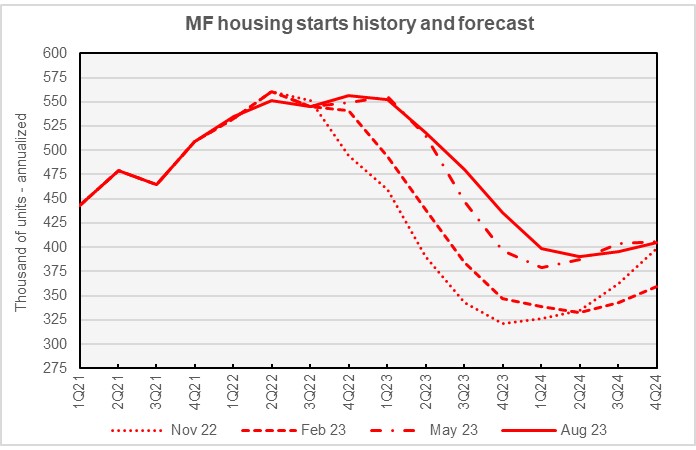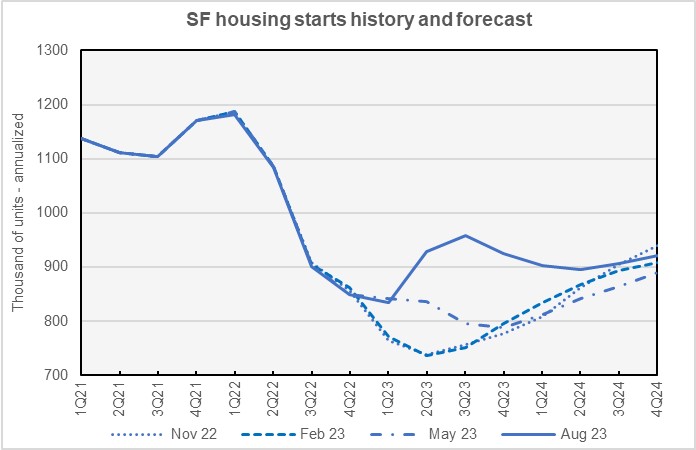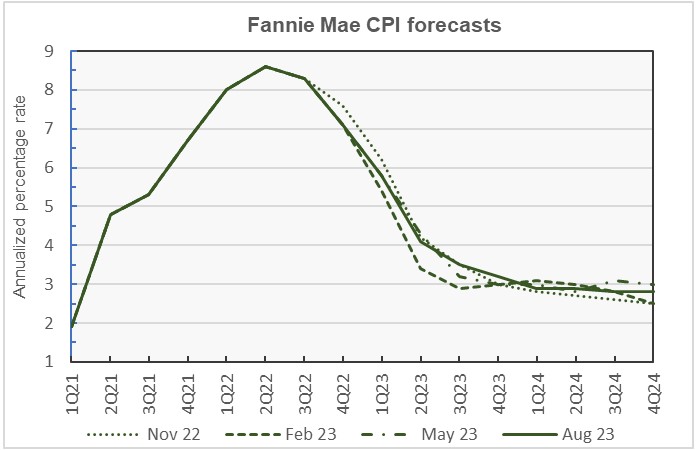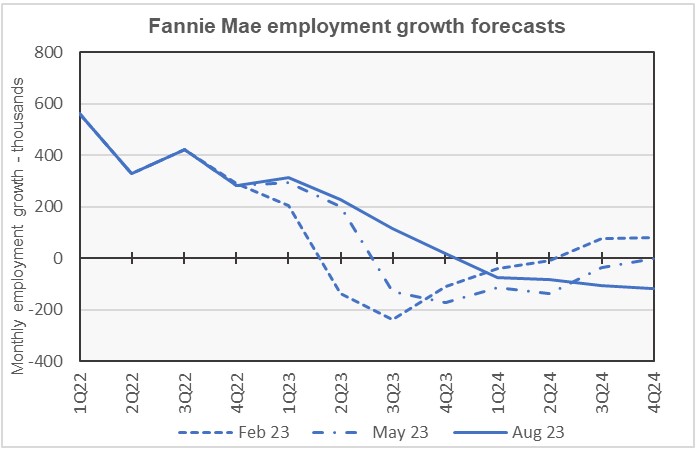Fannie Mae’s August economic and housing forecast predicts higher single-family starts but lower multifamily starts than did last month’s forecast.
Multifamily starts slow
The current forecast for multifamily housing starts is shown in the first chart, below, along with three other recent forecasts. Fannie Mae considers any building containing more than one dwelling unit to be “multifamily”, including both condominiums and rental housing units.

While the chart shows that the forecasters have progressively delayed the expected start of the multifamily construction downturn and reduced its forecast depth compared to the earlier forecasts shown, the August forecast is actually less positive than was the July forecast. The August forecast for multifamily starts is lower than the July forecast for every quarter from Q2 2023 through the end of 2024.
The largest quarterly revision from last month’s forecast was for Q2 2023 with a downward revision of 47,000 units, annualized. The lowest annualized rate of multifamily housing starts is now predicted to be 390,000 units in Q2 2024. This is 17,000 units lower than the lowest annualized starts rate predicted in last month’s forecast and the low point in starts occurs one quarter later.
Compared to last month’s forecast, the predicted number of multifamily starts in 2023 was revised downward by 16,000 units to 496,000 units. The predicted number of multifamily starts for 2024 was also revised downward by 16,000 units to 398,000 units.
Improving outlook for single-family
The current forecast for single-family housing starts is shown in the next chart, below, along with three other recent forecasts.

For the second month in a row, Fannie Mae’s forecasters raised their predicted numbers for single-family starts over the entire forecast horizon. Fannie Mae now expects single-family starts to be 912,000 units in 2023, up 16,000 units from the level forecast last month. Fannie Mae now expects single-family starts to be 907,000 units in 2023, up 17,000 units from the level forecast last month.
Later GDP downturn, later recovery
The next chart, below, shows Fannie Mae’s current forecast for Gross Domestic Product (GDP) growth, along with other recent forecasts.

The chart shows that Fannie Mae’s forecasters have repeatedly delayed the expected date of the recession compared to recent forecasts. They now expect the first quarter of negative GDP growth to be Q1 2024, one quarter later than in last month’s forecast. The greatest economic contraction is now expected to occur in Q2 2024 with negative growth of 0.9 percent, annualized. Positive GDP growth is expected to return in Q4 2024. This is one quarter later than predicted in last month’s forecast.
The full year forecast for GDP growth for 2023 was revised upward by 0.8 percentage points to 1.9 percent. The full year GDP forecast for 2024 was revised downward by 0.1 percentage points to -0.2 percent.
Inflation forecast nearly unchanged
The next chart, below, shows Fannie Mae’s current forecast for the Consumer Price Index (CPI), along with three other recent forecasts.

Fannie Mae’s inflation forecasts have not been revised to the same degree as have their other forecasts discussed here. Over the last 6 forecasts, every quarterly inflation forecast for 2024 has been between 2.7 and 3.1 percent. The current forecast has the rate of inflation as measured by the CPI declining somewhat more slowly in 2023 and remaining nearly flat in 2024. It calls for inflation to be running at 2.8 percent year-over-year at the end of 2024, well above the Federal Reserve’s target of 2.0 percent.
The forecast for year-over-year CPI growth in Q4 2023 was revised upward from last month’s level by 0.1 percentage points to 3.2 percent. The Q4 2024 inflation forecast was revised downward by 0.1 percentage point to 2.8 percent.
Job growth higher in 2023
The next chart, below, shows Fannie Mae’s current forecast for employment growth, along with two earlier forecasts. Employment growth is our preferred jobs market metric since job gains, along with productivity gains, drive economic growth.

Fannie Mae revised the population base used for their forecasts in February 2023, so that is the earliest forecast whose numbers can be compared to those in the current forecast.
Fannie Mae’s forecast for job growth in 2023 has steadily increased in every forecast since February as the forecast start date of the expected downturn has been delayed. The August employment growth forecast calls for the highest number of job gains for 2023 of the last 7 forecasts. However, the forecast number of job losses for 2024 is down from the level in last month’s forecast.
The first quarter with declining employment levels is now expected to be Q1 2024, one quarter later than in last month’s forecast. However, the expected job losses during the downturn are predicted to be lower and to come on more gradually than foreseen last month.
Compared to last month’s forecast, the expected full year forecast for employment growth in 2023 was revised upward from a gain of 1.8 million jobs to a gain of 2.0 million jobs. The employment growth forecast for 2024 was revised from a loss of 1.4 million jobs to a loss of 1.1 million jobs.
The Fannie Mae forecast can be found here. There are links on that page to the detailed forecasts and to the monthly commentary.













